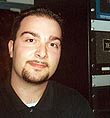|
|
This topic comprises 2 pages: 1 2
|
|
Author
|
Topic: DTS6 output level
|
|
|
|
|
|
|
|
|
|
|
|
|
Steve Guttag
We forgot the crackers Gromit!!!

Posts: 12814
From: Annapolis, MD
Registered: Dec 1999
|
 posted 04-11-2004 09:29 AM
posted 04-11-2004 09:29 AM




Mark,
I don't agree on the pink noise of DTS to set its level. Buss level is buss-level...if the 1KHz tone is acurately recorded...the level is right...no room for error. Without exception, when done this way there has been zero difference in level between DTS digital, Dolby Digital and analog. The only real purpose to those trims in a DTS unit is to allow the DTS player to match the buss level of a particular processor.
DTS Rev C disc has good tones to use (including subwoofer) as does the latest DS disc (I forget its revision but it also has a tone for the subwoofer channel unlike previous DS discs).
Pink noise as a level setting tool has always been a bit flawed. It is a random noise (hopefully) and provides a wavering level. With pink noise, you are dependent on every step in the process of its making...the generation of the original white noise source, the conversion to pink noise via LPF, the proper band limiting...then there is the digitizing of the signal (for a DTS disc), then comes the meter stage...you again must have a meter that has accurate filters and a uniform sensitivity across the spectrum being measured (dB level measurements are meaningless without a well defined spectrum)...lastly the method of obtaining the measurements comes into play...do you hold the meter at chest height, ear height, point at the speaker playing, point straight ahead, point at the ceiling, is your body affecting the results...I've yet to find two different people to come up with the same numbers.
As to the other statement of not using tone for setting room levels...since room levels are set after B-chain tuning (unlike digital processor levels which come before B-chain tuning), a single frequency band would be affected if that particular band was adjusted. That is, if 1KHz tone was used, if you adjusted the 1KHz EQ control, it would, in effect, be setting the balance of the channel. Pink Noise wins in this area since the entire spectrum is excitd and the log average of all represented frequencies are used.
Using a pink noise card or the processors internal pink noise generator is more accurate than using a pre-recorded disc since for a certainty, in either processor generated noise you have the exact same signal sent to all channels so even if the Pink Noise is inaccurate, it will be uniform across all channels and balance is maintained. Using a DTS disc, one is dependant on how it was recorded and digitized. It is certainly possible that it too is accurate and I don't dispute you have had excellent results but it opens the possibility of inaccuracy.
Certainly the same argument can be made about using a tone method though recording a single tone is a much less complex signal to digitize and easier to maintain since when recording pink noise for level, one must again band limit it and average out the level where as a tone is a steady state signal and inherently band limited. One of the many things I like about the XD-10 is that right out of the box, the levels are set to the 300mV buss level and may, if the processor so dictates, be adjusted in .5dB increments up or down.
Steve
| IP: Logged
|
|
|
|
|
|
|
|
|
|
|
|
|
|
|
|
|
|
|
|
All times are Central (GMT -6:00)
|
This topic comprises 2 pages: 1 2
|
Powered by Infopop Corporation
UBB.classicTM
6.3.1.2
The Film-Tech Forums are designed for various members related to the cinema industry to express their opinions, viewpoints and testimonials on various products, services and events based upon speculation, personal knowledge and factual information through use, therefore all views represented here allow no liability upon the publishers of this web site and the owners of said views assume no liability for any ill will resulting from these postings. The posts made here are for educational as well as entertainment purposes and as such anyone viewing this portion of the website must accept these views as statements of the author of that opinion
and agrees to release the authors from any and all liability.
|

 Home
Home
 Products
Products
 Store
Store
 Forum
Forum
 Warehouse
Warehouse
 Contact Us
Contact Us




 Printer-friendly view of this topic
Printer-friendly view of this topic













